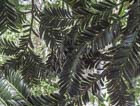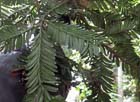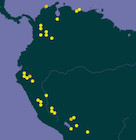Pectinopitys harmsiana
(Pilg.) C.N.Page 2019
Common names
Uncumanu (in Peru; Farjon 2010), yellow miro (Eckenwalder 2009). Also diablo fuerte, guayrurillo, romero romerillo, romerillo hembra, saucecillo, ulcumanu, and tarcu; in the lumber trade it is generally called romerillo (Anonymous 2019). These names seem to commonly be applied to nearly any South American podocarp exploited for its timber (the most common are probably Podocarpus oleifolius and Retrophyllum rospigliosii, simply because these species are still fairly abundant); if you want to distinguish these timbers, you should probably consult Correa et al. (2010) and Villanueva et al. (2021).
Taxonomic notes
Type A. Fendler 1289, Tovar, Cordillera de Mérida, Venezuela. Synonymy:
- Podocarpus harmsianus Pilg. ex Engler 1903;
- Podocarpus utilior Pilg. 1905; and
- Prumnopitys harmsiana (Pilg.) De Laub. 1978.
Pilger described Podocarpus harmsiana on the basis of collections of foliage and pollen cones, and, two years later, described P. utilior on the basis of a collection from Peru. These have now been confirmed to be the same species (Farjon 2010). Page (2019, p. 148) assigns this species to Pectinopitys rather than Prumnopitys on the basis of evidence observable on herbarium collections; field characters are not discussed and it appears no molecular work has yet been performed.
Description
Trees to 35 m tall and 180 cm dbh, with an erect trunk bearing ascending and spreading branches, forming a rounded crown. Bark first smooth, later becoming scaly, exfoliating in thin strips; purple-brown, weathering to gray. Foliage on young plants straight to falcate, 20-30×2-4 mm, apex acute. Foliage on mature plants alternate, twisted at a petiolate base to appear two-ranked, slightly curved, (8-)15-20×2-3.5 mm with a raised midrib on both upper and lower sides; apex mostly obtuse; dark green above, glaucous below. Pollen cones borne on 3-4 cm long lateral axillary spikes near the ends of branches, with 15-20 cones axillary to 2 mm long bracts, cones each 8-10×2 mm. Seed cones solitary on 1.5-2.5 cm long axillary twigs, with an epimatium containing an ovoid, slightly flattened, rugose seed; at maturity the cone is subglobose, up to 10 mm diameter, greenish yellow. The plant resembles Prumnopitys montana, but that species has a leaf midvein grooved on the upper side, and grows at somewhat greater elevations (Eckenwalder 2009, Farjon 2010).
Distribution and Ecology
The Andean mountain areas of Venezuela, Colombia, Ecuador, Peru, and Bolivia, at elevations of (1,000)1500-2,200(-2,800) m, corresponding to lower montane and montane settings. Uncommon, mostly occurring as individuals or small groves in primary and secondary forest. Most collections are from Bolivia and Peru. The native habitat type is being lost to deforestation, but since the actual area of occupancy is not well known, neither are the implications of this loss for species conservation (Eckenwalder 2009, Farjon 2010).
A forest inventory conducted by Yaguana et al. at a reserve adjoining Podocarpus National Park in Ecuador illustrates the complexity of native podocarp forests in the Andes (this particular site being at an elevation of 2,100 m). In a 1 ha plot there were 1,091 trees representing 171 tree species; the two most dominant species, representing 80% of total wood volume, were the podocarps P. harmsiana and Retrophyllum rospigliosii; the plot also included "numerous species of Rubiaceae, Lauraceae, Meliaceae, Myrtaceae and Melastomataceae" as well as a few Podocarpus oleifolius (Yaguana et al. 2012). The plot timber volume of 652 m3ha-1 is very high compared to typical Neotropical forests; Yaguana et al. (2012) describe this site as "one of the last remnants of these 'giant forests' of Podocarpaceae in the tropical Andes."
The IUCN classifies this species as "Near Threatened" by human impacts. It has a wide distribution in general, but in Ecuador and Colombia is threatened due to small subpopulations and habitat loss through deforestation. It is subject to active exploitation for timber, being preferentially chosen during selective logging, throughout most of its range. Remaining populations are severely fragmented and reproductively isolated from each other, and most threats are severe, with the prospect of relatively rapid future declines (thus the most recent assessment is likely outdated by now). Fortunately, the species occurs in many protected areas (Gardner 2013).
Remarkable Specimens
There are few data. The largest specimen found in the study by Yaguana et al. (2012) described above was 29 m tall with a 128.3 cm dbh.
Ethnobotany
The timber is highly valued for construction and large trees are often selectively logged. However, the species is not found in cultivation except in a few botanic gardens and arboreta (Farjon 2010).
Observations
It occurs in Machu Pichu National Park in Peru. It is also reported from National Park Yanachaga Chemillen, Peru. Rarely seen in arboreta and botanical gardens, it is not known to be used as an ornamental (Farjon 2010).
Remarks
The epithet remembers German botanist H. A. T. Harms (1870-1942), a colleague of Pilger and an editor of Das Pflanzenreich, which published the original description of the species (Eckenwalder 2009).
Citations
Anonymous. 2019. Resolucion de Direccion Ejecutiva No. 118-2019-MINAGRI-SERFOR-DE Anexo Lista Oficial de Especies Forestales. https://faolex.fao.org/docs/pdf/per188296anx.pdf, accessed 2023.02.26.
Correa, Á. M. V., Vara, E. A. and Machuca, M. Á. H., 2010. Wood anatomy of Colombian Podocarpaceae (Podocarpus, Prumnopitys and Retrophyllum). Botanical Journal of the Linnean Society 164(3):293-302.
Gardner, M. 2013. Prumnopitys harmsiana. The IUCN Red List of Threatened Species 2013: e.T32287A2812675. https://dx.doi.org/10.2305/IUCN.UK.2013-1.RLTS.T32287A2812675.en, accessed 2023.02.26.
Page, Christopher N. 2019. New and Maintained Genera in the Taxonomic Alliance of Prumnopitys s.l. (Podocarpaceae), and Circumscription of a New Genus: Pectinopitys. New Zealand Journal of Botany 57(3):137–53. https://doi.org/10.1080/0028825X.2019.1625933.
Villanueva, Baselly Juan Rodrigo, Gianmarco Goycochea Casas, Ana Marcia Macedo Ledeira Carvalho, Wálter Ricardo Roncal Briones, Sheyla Yanett Chumbimune Vivanco, and Manuel Chavesta Custodio. 2021. Caracterización y diferencias anatómicas de maderas de Retrophyllum rospigliosii (Pilg.) CN Page y Prumnopitys harmsiana (Pilg.) de Laub. (Podocarpaceae) procedentes de la provincia de San Ignacio, Perú. Folia Amazónica 30(2):137-148.
Yaguana, Celso, Deicy Lozano, David A. Neill, and Mercedes Asanza. 2012. Diversidad florística y estructura del bosque nublado del Río Numbala, Zamora-Chinchipe, Ecuador: El “bosque gigante” de Podocarpaceae adyacente al Parque Nacional Podocarpus. Revista Amazonica: Ciencia Y Tecnología 1(3):226-247. Available: https://www.uea.edu.ec/revistas/index.php/racyt/article/view/19, accessed 2023.02.26.
See also
The species account at Threatened Conifers of the World (accessed 2023.02.26).



